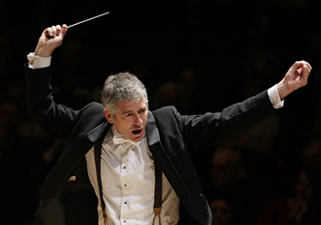The cooperation between the NC Symphony and Peace College in the Jewel Edgerton Williams Chamber Music Series has had two important outcomes: It has brought us a series of excellent – often fascinating – concerts and it has given members of the NCS a venue for chamber music and solo performances.
Last night, in a concert that stretched from the relatively new to the obscure and finally to the most popular, was no exception. The program opened with cellist Elizabeth Beilman and clarinetist Jimmy Gilmore performing Squaring the Circle, a work by composer J. Mark Scearce, a familiar name in the Triangle since his years as Composer-in-Residence at NCSU. The programming was fortuitous, since the work was composed in 1991 in response to the first Gulf War and with inspiration from “.the big, colorful Frank Stella Raqqa II at the N.C. Museum of Art, itself inspired by Iraqi art.” According to the composer , the music is based on an Iraqi mode, which required Beilman to retune her cello to A-flat, D-flat, F and C. In the first movement, with the cello providing a four-note drone accompaniment on open strings, the clarinet performed a mournful arabesque that definitely sounded middle-eastern.
The second movement explained the title – as did Gilmore in amusing but crucial oral program notes. In the center of the score was a “magic square,” the numbers from 1 to 16 arranged in a square divided into 16 smaller squares so that the sum of each horizontal and vertical line, as well as of the two diagonals, adds up to 34. Surrounding the square were sixteen numbered fragments of music to be played in the sequence of the four numbers in one of the trajectory of small squares, chosen at the performers’ discretion. It was up to the performers to choose which five or six of the 20 possible sequences they decided to play. Scearce also wrote percussive elements into the score so that Beilman beat a syncopated rhythm on the body of the cello with the fingers of both hands, while Gilmore “bell-popped” the bottom of the clarinet with the flat of his hand to accompany the cello in a bridge melody between the four-fragment melodies. It was a clever arrangement and would have delighted any medieval numerologist. The music was tonal, pleasant and technically challenging. Beilman and Gilmore were clearly familiar with the work and enjoyed playing it.
The Armenian composer Aram Khachaturian is known in the West mainly through his ballets Gayane and Spartacus with their orientalism. One of the jobs of Soviet composers in the 1930s and 40s was to “create” classical music with the ethnic music of the USSR’s many minorities. Khachaturian’s Trio for Clarinet (or viola), Violin and Piano of 1932 is an attempt to create an Armenian classical style but it frequently reverts to the pseudo orientalism of Rimsky-Korsakov and his contemporaries. The music, especially of the first movement, is Hungarian café music gone east, and Gilmore, with pianist Milton Laufer of the Peace College faculty and violinist Brian Reagin, were at times a little too formal and stiff for such loose music.
To end the program, Laufer, Reagin and Beilman were joined by violinist Rebekah Binford and violist David Marschall in Robert Schumann’s Piano Quintet in E-flat, Op.44. It was a spirited performance, but the sustained forte in their interpretation of the first movement was too much for the small hall. And in the second movement, In modo d’una marcia, the viola – when carrying the theme – did not emphasize the march beat enough, making the music languid, rather than solemn. But overall the enthusiasm of the players was infectious and generated an exciting performance.











